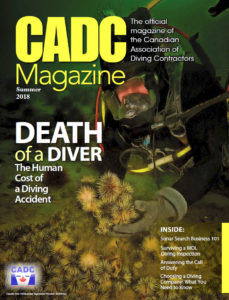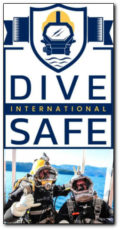CADC MAG SUMMER 2018 AVAILABLE FOR DOWNLOAD
By CADC Admin ~ June 19th, 2018. Filed under: CADC MAG, Latest Diving News, Safety.
It’s About time. It’s About lives.
It’s spring/summer of 2018, and diving operations are in full swing in this thawed-out Canadian land. On the paperwork side, it has been a busy winter, too, as the CSA Diving Standards and the Offshore Petroleum Boards have been working on updating standards and the formulation of new offshore regulations effecting our Canadian East Coast. Standards, regulations and operational procedures are the industry stakeholders’ efforts to minimize the risk in a profession that can be risky—but safe, if done right.
But what is the cold, hard reality of an incident gone wrong when procedures that we work hard on are not followed—or are simply ignored?
Our feature article, Death of a Diver: The Human Cost of a Diving Accident, is one of these stories. Joey Oickle, a Nova Scotian sea urchin diver and entrepreneur, conducted diving operations as he had for years. It was a simple procedure. Throw three divers off a boat, have them descend to the ocean floor, gather sea urchins in a bag, surface and blow a horn or whistle, and get picked up. Unload the bag. Repeat. Did it that way for years.
And nothing happened for years—until a fateful day in 2012 when the third diver, Larry Collins, did not surface (or did surface but was not seen), and was never seen again. Lost at sea.
Six months later, frustrated by delays and debt mounting up, Oickle ignored a Stop Work Order and went out to sea again. And, again, he lost a diver. This time, the diver was found drifting on the surface 30 minutes later by the coast guard—he was five miles away!
The death of the first diver, Larry Collins, was tragic. Families of the lost diver and the boat crew involved in the accident were, of course, deeply affected by the accident.
There is a true human cost in an accident—any accident—for ALL who are involved. Read Death of a Diver: The Human Cost of a Diving Accident on page 12 to understand why safety is important and just how it can cost everyone who is involved. It is not a situation you want to find yourself in.
DOWNLOAD:CADC MAG SUMMER 2018 SM FINAL
There are those who make the laws and regulations, and there are those who enforce them. What happens when one of those enforcers shows up on YOUR job site? Bob Landry, a former Ontario Ministry of Labour diving inspector, gives advice on how to survive a visit from an inspector on a dive site. It starts with, “Good morning, I’m from the government and I’m here to help you.” Turn to page 19, and Landry will walk you through the visit and do his best to help you come out the other side.
Want to get into the sonar search business? Mark Atherton of Kongsberg Mesotech gives us some advice on the realities of the business and how to make some loot while you’re at it. It’s not all rocket science, but you have to know a few things to make some money at it. Mark gets us geared up for it in the first of a two-part series starting on page 17.
From dam work, to cruise ship berthing installations, Global Diving & Salvage Inc.’s diversified operations are shown in this article about their work in the Pacific Northwest and Alaska. As you will read about on page 22, they are up to the challenge of complex underwater and marine construction.
The Canadian Forces Experimental Diving and Undersea Group (EDUG) located in Toronto is the heartbeat of experimental diving for the military diving community. Lt. Alexander DeLorey gives us a peek at what they do there (on page 26). It’s more than just military diving.
Hiring a professional dive contractor is not a mystical science. Choosing the right diving contractor who is aware of and follows the regulations and standards safeguards both the client and the worker from unsafe diving practices. Once again, we include this important guideline in our spring/summer issue (see page 24).
As this issue goes to press, the CSA has approved the removal of the clause in the CSA Z275.2-15 that allowed the use of a three-man minimum dive crew in surface supplied diving operations. Effective October 2018, only a minimum of a four-man qualified dive crew will be allowed on any operations following the Z275.2 CSA dive standards. Occupational SCUBA diving operations minimum dive crew will also be reviewed in the fall. It’s about time. It’s about lives. More on this in the fall issue of the magazine.
DOWNLOAD:CADC MAG SUMMER 2018 SM FINAL







